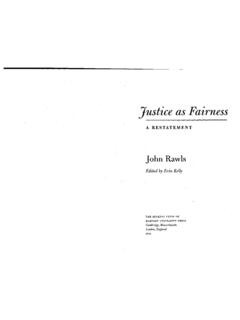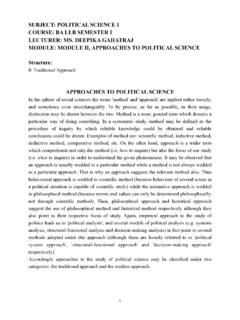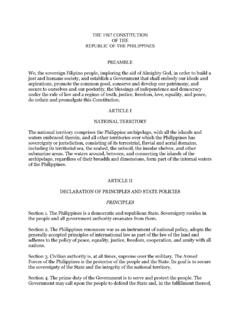Transcription of What Is a Constitution? Principles and Concepts
1 What Is a constitution ? Principles and ConceptsAugust 2014 About this seriesThese constitution -building primers are intended to assist in-country constitution -building or constitutional-reform processes by: (i) helping citizens, political parties, civil society organisations, public officials, and members of constituent assemblies, to make wise constitutional choices; and (ii) helping staff of intergovernmental organizations and other external actors to give good, well-informed, context-relevant support to local decision-makers. The primers are designed as an introduction for non-specialist readers, and as a convenient aide-memoire for those with prior knowledge or experience of constitution -building. Arranged thematically around the practical choices faced by constitution -builders, the primers aim to explain complex issues in a quick and easy International IDEAThe International Institute for democracy and Electoral Assistance (International IDEA) is an intergovernmental organization with a mission to support sustainable democracy worldwide.
2 International IDEA1 OverviewWhat Is a Constitution? The vast majority of contemporary constitutions describe the basic Principles of the state, the structures and processes of government and the fundamental rights of citizens in a higher law that cannot be unilaterally changed by an ordinary legislative act. This higher law is usually referred to as a content and nature of a particular constitution , as well as how it relates to the rest of the legal and political order, varies considerably between countries, and there is no universal and uncontested definition of a constitution . Nevertheless, any broadly accepted working definition of a constitution would likely include the following characteristics: A constitution is a set of fundamental legal-political rules that: (1) are binding on everyone in the state, including ordinary lawmaking institutions;(2) concern the structure and operation of the institutions of government, political Principles and the rights of citizens;(3) are based on widepread public legitimacy;(4) are harder to change than ordinary laws ( a two-thirds majority vote or or a referendum is needed).
3 (5) as a minimum, meet the internationally recognized criteria for a democratic system in terms of representation and human IDEA | constitution Building Primers2 The Functions of a constitution Constitutions can declare and define the boundaries of the political community. These boundaries can be territorial (the geographical borders of a state, as well as its claims to any other territory or extra-territorial rights) and personal (the definition of citizenship). Thus, a country s constitution often distinguishes between those who are inside and those who are outside the polity. Constitutions can declare and define the nature and authority of the political community. They often declare the state s fundamental Principles and assumptions, as well as where its sovereignty lies.
4 For example, the French constitution declares that France is an indivisible, secular, democratic and social Republic and that National sovereignty belongs to the people, who exercise it through their representatives and by means of referendums ( constitution of the Fifth French Republic). The constitution of Ghana (1992) states that, The Sovereignty of Ghana resides in the people of Ghana in whose name and for whose welfare the powers of government are to be exercised . Constitutions can express the identity and values of a national community. As nation-building instruments, Constitutions may define the national flag, anthem and other symbols, and may make proclamations about the values, history and identity of the nation.
5 Constitutions can declare and define the rights and duties of citizens. Most constitutions include a declaration of fundamental rights applicable to citizens. At a minimum, these will include the basic civil liberties that are necessary for an open and democratic society ( the freedoms of thought, speech, association and assembly; due process of law and freedom from arbitrary arrest or unlawful punishment). Many constitutions go beyond this minimum to include social, economic and cultural rights or the specific collective rights of minority communities. And some rights may apply to both citizens and non-citizens, such as the right to be free from torture or physical abuse. Constitutions can establish and regulate the political institutions of the community defining the various institutions of government; prescribing their composition, powers and functions; and regulating the relations between them.
6 It is almost universal for constitutions to establish legislative, executive and judicial branches of government. In addition, there may be a symbolic head of state, institutions to ensure the integrity of the political process (such as an electoral commission), and institutions to ensure the accountability and transparency of those in power (such as auditors, a court of accounts, a human rights commission or an ombudsman). The institutional provisions typically provide mechanisms for the democratic allocation and peaceful transfer of power ( elections) and mechanisms for the restraint and removal of those who abuse power or who have lost the confidence of the people ( impeachment procedures, motions of censure).
7 Constitutions can divide or share power between different layers of government or sub-state communities. Many constitutions establish federal, quasi-federal or decentralized processes for the sharing of power between provinces, regions or other sub-state communities. These may be geographically defined (as in most federations, such as Argentina, Canada or India), or they may be defined by cultural or linguistic communities ( the 1994 constitution of Belgium, which establishes autonomous linguistic communities in addition to geographical regions). Constitutions can declare the official religious identity of the state and demarcate relationships between sacred and secular authorities.
8 This is particularly important in societies where religious and national identities are interrelated, or where religious law has traditionally determined matters of personal status or the arbitration of disputes between citizens. What Is a constitution ? Principles and Concepts | August 20143 Constitutions can commit states to particular social, economic or developmental goals. This may take the form of judicially enforceable socio-economic rights, directive Principles that are politically binding on the government, or other expressions of commitment or constitution at the Intersection of Legal, Social and Political LifeAs legal, political and social documents, constitutions are at the intersection of the legal system, the political system and society. Constitutions as legal instruments: A constitution marries power with justice (Lutz 2006: 17) it makes the operation of power procedurally predictable, upholds the rule of law, and places limits on the arbitrariness of power.
9 It is the supreme law of the land, and it provides the standards that ordinary statutes have to comply with. Constitutions as social declarations: Constitutions often attempt, to varying degrees, to reflect and shape society for example, by expressing the (existing or intended) common identity and aspirations of the people, or by proclaiming shared values and ideals. These provisions are generally found in preambles and opening declarations, but can also be found in oaths and mottos or on flags and other symbols that are defined by the constitution . Other substantive provisions of the constitution , particularly those defining socio-economic rights, cultural or linguistic policy, or education, might also belong to this category (Lutz 2006: 16 7).
10 Constitutions as political instruments: The constitution prescribes a country s decision-making institutions: constitutions identify the supreme power , distribute power in a way that leads to effective decision making and provide a framework for continuing political struggle (Lutz 2006: 17). The political provisions show how state institutions (parliament, executive, courts, head of state, local authorities, independent bodies, etc.) are constituted, what powers they have and how they relate to one 1: A constitution as a Legal, Social and Political DocumentLEGAL (Justice):Foundation of legal system and citizens (Culture):Reflecting and influencing shared values & (Power):Power map of institutions of IDEA | constitution Building Primers4 Two Constitutional ArchetypesConstitutions balance and reconcile these legal, political and social functions in different ways.










